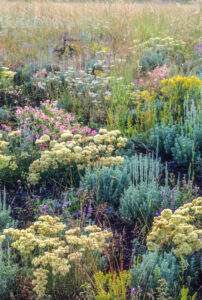
Introduction to Tom Murphy’s book The Light of Spring
Yellowstone’s spring can look like winter, spring, or summer. Winter is still very evident in late March. It can be twenty below zero in March. In early spring the snow begins to settle and melt. As the snow banks shrink, they are dirty; pine needles, dust, lichen, and other embedded materials fell and blew around over the snow, become visible on the surface. April is referred to as mud month, when the snow recedes and exposes long-buried brittle vegetation, pocket gopher trails, and soil churned up by the runoff.
Ungulates at the beginning of spring are at their weakest, thinnest, and most fragile. Depending on the weather, late winter and early spring is often the highest period of winter kill. The fat reserves, which carried the animals through the cold, snowy winter, have been depleted. They may not have enough strength left in early spring to survive if the snow melt and warmth do not give them relief soon. Even the ones who survive do not look healthy. In the spring warmth they shed their sun-bleached winter hair in patches and remind me of Salvation Army thrift store couches.
When animals emerge in spring from hibernation, all of them are hungry. Ground squirrels appear on the top of the snow looking for fresh green vegetation in the blinding bright light after six months in total darkness.
The rebirth on the landscape is the most spectacular aspect of spring. The extended daylight, the rapid growth of vegetation, the new green, and the wild array of flowers give us a rebirth of our own spirit All births are tied to the explosion of other births, the wild growth of plants and the abundance of insects. A few birds, such as owls, nest in late winter so their young hatch at the same time young rodents begin to appear above ground in April and May. One of the icons of Yellowstone, the bison, begins its birth cycle about the 20th of April and continues for a month. The rest of the ungulates begin their birth cycle about the 20th of May and also continue for a month.
During this two month period, when shivering little newborns are on the ground, it could be a sunny 70 degrees F or they have three feet of wet snow around them. With each birth, a newborn’s struggling, bewildered, innocent energy mimics what went before but carries the possibility of new strengths. The mother’s amazement and tender nuzzling has much of the same innocence and optimism as the struggles of the newborn. They hold the future there for themselves, for us, and for all of life in the universe. We can see how small and fragile each of us is, yet how overwhelmingly powerful the force of life is.
Migratory birds return optimistically to raise another generation in a place that has been uninhabitable to them for the last six or seven months. The spring season floods warmth, light, and food over the land to provide the nursery for uncountable animals from mosquitoes to grizzly bears. Birds move through this world utilizing nearly every niche, some are feeding on stone flies under the water in Slough Creek, and some are feeding on the spiraling clouds of midges in the Hayden Valley. Birds observe Yellowstone from all over: the broad soaring wings of the red-tailed hawk from 1000 feet above the Lamar Valley, a group of cowbirds from the fuzzy back of bison, or the dipper from its wet mossy nest stuck to a misty cliff alongside Tower Fall.
A plant gets help dispersing its offspring by producing edible fruit, berries, and seeds. But flowers: what a clever way for a plant to recruit insects, birds, and bats to participate in its reproduction. The most creative, selfish, and devious thing that a plant does is to produce flowers with aromas, colors, and shapes which attract an entirely different kingdom of creatures into its parlor. It could be inviting catastrophe, but by giving an animal a bit of sweets, a root bound plant gets clever, active creatures to carry its genes to the handsome neighboring plant three feet or three miles away. The animal thinks it is stealing nectar, but the nectar was actually just the bait. The plan all along was to have a wild excess of pollen and sweets laid over the path or flung over the bodies of the welcomed thieves and passively let them go on their way to steal other’s nectar. Scuffling creatures unintentionally carry pollens to all the parlors they visit, much to the plant’s benefit and the animals’s total ignorance.
There is a steady succession of color and variety in Yellowstone’s flowers. The earliest spring flowers, such as dogtooth violet, spring beauty, fritillary, and shooting star, give way to the ones that wait until the ground is warmer: fairy slipper, geranium, blue flax, and silky phacelia. The colors are scattered, mixed pooled and clustered on the land. One week, a meadow will exhibit a light rosy haze from thousands of shooting stars; then a few weeks later the dominant color is yellow from cinquefoil and buttercup and even later the blue of the wild iris. The colors of spring change in one area as the season progresses, but the colors also move up the mountains because an increase in elevation works like an increase in latitude. Early spring vegetation appears along the lower Gardner river in April, but doesn’t arrive at Dunraven Pass until June. We can have all the colors of two seasons somewhere in Yellowstone through most of June. When it is summer around Gardiner, it is early spring on the Absaroka and Gallatin Divides.
In my photographs, I try to illustrate in a simple, relevant and clear way the beauty of our natural world. We can see only what we understand; therefore, one role of art is to expand our circle of awareness. The complex natural world will forever keep us straining to gaze out beyond the present reach of our awareness. Each of us came from the same star dust, yet we often make our individual uniqueness a barrier to other lives. Every other life has the same individual uniqueness as ours, visible if we look closely. As we travel on our short visit here we constantly commingle with other parts of the universe. We share the water, the air, and the soil with all other creatures. Starlight touches us from the suns which have faded to darkness before our sun appeared. These particles of matter that we now call ours came from stars and will eventually become parts of other stars. To positively influence our world, we must carry our unique and communal star dust so that we contribute light and beauty to the space and this time we have.
Tom Murphy
